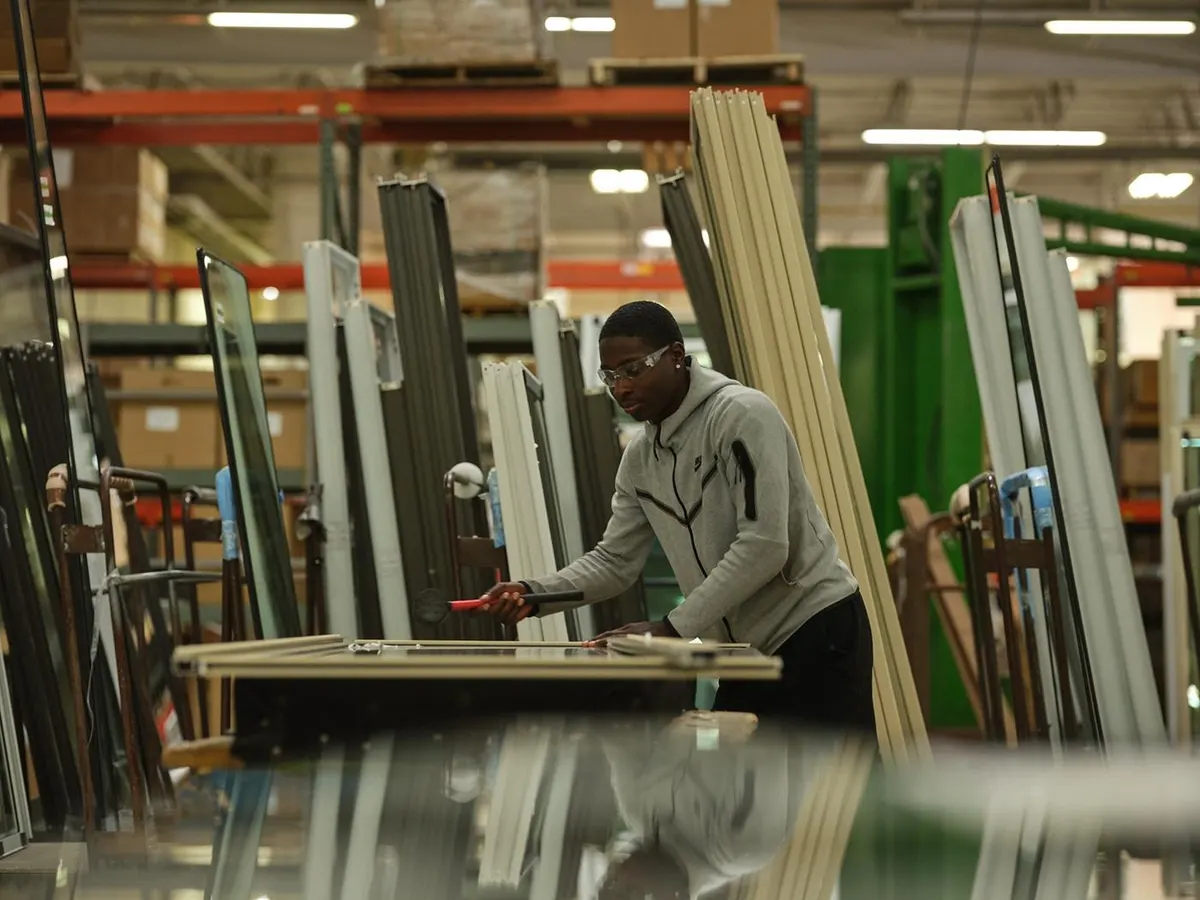By Contributor,Jennifer Castenson
Copyright forbes

Great Day Improvements’ vertically integrated manufacturing and installation strategy enables the company to offer peace of mind to homeowners with window, door, bath, gutter and sunroom products.
Great Day Improvements
The homebuilding industry wrestles with the negative consequences of fragmentation. Many stakeholders own and control different stages of the process, putting stressors on the overall system and stagnating efficiency because the various stakeholders have individual goals to meet and individual profit to make.
So, innovators in housing are bringing traditionally outsourced operations in house to streamline processes, reduce costs, and increase efficiency.
Vertical Integration Boosts Profits
By handling various stages of the development process internally, from land acquisition to construction and sales, companies can eliminate the markups charged by external vendors and subcontractors. This leads to reduced transaction costs and the ability to leverage economies of scale, ultimately boosting profit margins. For example, a company that manufactures its own trusses can save on the costs of purchasing them from a supplier.
Plus, vertical integration can give companies more power in the market, which can lead to increased revenue.
“It feels like a stark contrast from previous years in, for example, the prefab space after the fall of Katerra,” said Tyler Ashby, partner at GroundBreak Ventures. “Then, it was don’t try to do it all yourself, stay asset lite, partner broadly, don’t take on too much risk.”
He sees the market shifting to startups that have greater ownership to better manage a fragile supply chain. Startups also want to do more for customers to limit the risk of being an interchangeable part of a “stack.” Plus, the higher level of process control helps companies get to more predictability and certainty.
MORE FOR YOU
Online land intelligence platform, Acres, vertically integrated the land strategy portion of the build process. By using technology and data, Acres marries all aspects of the land acquisition process to bring a calculated lens to zoning, sewer lines, environmental risks, population growth, and dozens of other impacts.
“It’s all about empowering builders to make faster, smarter decisions, which is the key to both vertical integration and saving significant cost,” said Carter Malloy, founder and CEO at Acres. “They can instantly vet a property and avoid costly surprises. Our tools then let them manage their entire pipeline, from initial prospect to owned asset, giving them a bird’s eye view of their inventory and process.”
Acres has transformed the fragmented process of land acquisition into a centralized system, by using data and technology in new ways.
Going Vertical Provides Operational Efficiencies
Managing more of the building process in house gives greater control over the entire project by enabling better coordination, and faster decision making. Those efficiencies mean less time on the job, which in turn means cost savings.
Similar to Acres, TurboPermit is using data and technology to centralize the permit management process and to help contractors obtain construction permits faster.
“Builders are using TurboPermit to take on more housing projects and accelerate approvals by 50%,” said the company’s founder Robbie Leer. “Time is money, and often they are saving months. Project teams are pulling revenue forward and reducing holding costs by thousands of dollars per day.”
Cost and time savings also come from controlling more of the supply chain, which reduces the risk to disruptions like material shortages or tariffs.
As owner of former building products retailer Ambassador Supply and investor in automated home building company AUAR, Rival Holdings is gathering companies together to reduce the friction in the processes to innovate on cost and time savings.
Not only that, but Rival is using small startups like AUAR that have the flexibility to try new approaches.
“We used the worst quality wood successfully, as well as Canadian and European quality timber, which helps us understand our capability to manage the supply chain and work with local product,” said Mollie Claypool, AUAR’s co-founder and CEO. “Now we know we don’t have to only work with one type of wood, it opens it up for variability with local supply chains. Plus, with Rival, we could integrate the supply chain with their lumber yards, and home builder, to understand how that can create a clear supply chain offering and platform.”
The partners are also exploring manufacturing processes and partnerships that can provide predictability and derisk cost.
“We need to approach this in a more granular way, by integrating into how homes are already built. That way, we can stand out through customization, developing a solution that supports nonstandard outcomes within a single workflow, while requiring less capital,” Claypool said. “In other words, instead of relying on standardization, we achieve production through horizontal scale.”
The company plans to deliver three homes in 2025 that will unlock the production of 1,000 more. Those three homes represent three distinct product types—infill, workforce housing, and an affordable duplex.
Rival Holdings also recently purchased Indiana-based homebuilder Davis Homes, a company that will directly benefit from the experimentation happening with infill projects. The dynamic partnership of Rival and AUAR aims to deliver 200 affordable homes next year, nailing the processes to deliver affordability then incrementally increasing the quality relative to building performance over time. Claypool said the plan initially is to prove out cost.
Rival and AUAR also are evaluating the next generation micro-factory. Currently, AUAR’s mini factories can be deployed in other warehouse or manufacturing spaces to be close to a project site. The next generation micro factory is the size of a three-car garage and can even be set up on the foundation of a house that is the first in a community while other homes are built around it.
“There is about a 150-mile radius around a factory where it works to deliver homes in offsite construction traditionally, so it makes sense to remove the logistics costs,” she said. “It also reduces coordination costs. In the future, we may look at ways to own the transportation, plus develop a logistics partnership with distributors.”
Here are other offsite construction companies using vertical integration to deliver higher quality and lower cost homes.
Quality and Customer Satisfaction
With direct control over more of the project, vertically-integrated companies can maintain higher quality standards. That control over the project also opens up the process to allow for more transparency and drive a better customer experience. A single point of accountability can mean smoother project execution and a more direct route from vision to reality for a customer.
Part of a better customer experience is ease and convenience, especially at a low cost.
Melissa Kaspers is the president and COO at online building material retailer GoSource, a company that is leveraging technology for volume buying power and as a value add to vertically stack retail sales with other parts of a remodeling or construction process. For instance, GoSource offers materials, labor, and technology to multifamily property owners to facilitate unit turns.
The company is using AI technology to improve the improve product ordering with more transparency and speed for cost savings and plans to expand to sell direct to builders, designers and architects offering lower prices on top of an AI layer to boost the shopping experience and to streamline the procurement process. Users can take a picture, submit the picture for AI to analyze and produce a full quote.
“We’ve built the technology to facilitate the sale and the delivery as a value add to the users,” Kaspers said. “Our technology solution on top of pricing is a differentiator. We’re offering real value that is very sticky. We don’t charge anything for the technology. Our users get better pricing for the product and pass that value along as well.”
Construction project management platform, Buildxact, has created an end-to-end solution for small- and medium-sized residential construction businesses that creates speed and improves accuracy with AI-powered features. Plus, the company has integrated live pricing from The Home Depot and even enabled purchasing and receipting from the retailer within its platform.
“Having the purchasing within the platform means one less interface for a builder who is already time starved and has the daily challenges of running their business,” said Steve Yates, CEO at Buildxact. “With this new functionality, a builder can go from uploading a design to managing subs and schedules to purchasing and cost tracking all in one platform. We are focused on the technology and partnerships to help them control all aspects of the project with little to no jumping around.”
Maor Greenberg started with a construction company and has worked tirelessly to solve for some of the friction he sees in the industry.
“We are working to create a trust element because we’re in an industry that is so old and routine it’s hard to get people to change,” Greenberg said, now serving as the co-founder and CEO at startup Spacial AI. “Architecture is the beauty of a project, the builder is the executer, but the engineers are the ones making the shots. We believe engineering shouldn’t be a black box, so we made the design and permitting process transparent, fast, and fully coordinated, all in one system.”
Seeing that the engineers have a majority stake in the control of a project, he created an AI platform to automate structural and MEP plan generation from 2D floorplans, basically removing engineering as a stakeholder to eliminate the manual drafting process, along with the engineering coordination. After a design is uploaded, Spacial generates a permit-ready, stamped plan in a matter of days when it typically takes weeks.
The vertical integration this technology offers not only creates process efficiencies, but it also provides higher quality outputs that can be used by more of the project stakeholders. The design conversion will show conflicts and communicate the designs in a way that doesn’t need technical expertise.
“Today’s tools are mostly for the builders, but the builder isn’t on the job site every day,” Greenberg said. “We are building tools to get to a level so a human only needs to be involved for a couple hours. We are building so we can do a very accurate takeoff because we own the engineering and we will even do the procurement, so it’s all end-to-end on one platform. With Spacial, architects and builders take back control.”
Strategic Advantages
With the direct management that vertical integration allows, companies can better manage risks that come with market fluctuations and economic downturns. That control also provides the flexibility to adapt to change easier.
For Drew Weinfurtner, CEO of remodeling company Great Day Improvements, vertical integration offers differentiation along with efficiencies. The company’s unique approach is to manufacture its own product.
“For us it’s about having a differentiation,” he said. “Efficiency needs to come with the manufacturing, but also differentiation. We invest a ton into product development and what the consumer is after. There is a capital investment and we get some return through efficiency and some through market demand to sell more. Mixture of the two that go into a ROI calculation benefit to the customer with cost that we can control better and benefit to the business from the efficiency standpoint.”
Great Day Improvements also chooses to offer extensive warranties by product line that are 100% transferable to new homeowners. This business model has helped Great Day grow nationwide, leveraging that presence to create relationships for life underpinned by the customer experience.
“What Great Day represents is the trust that is so often missing with contractors and the vertical integration is the foundation of that,” Weinfurtner said. “The knock in the industry is the lack of trust and inconsistency from contractor to contractor. We provide trust and control through the process because we control the supply chain, so we keep costs lower relative to competitors who are held hostage by suppliers.”
As the company grows, it is reinvesting in its business to remain customer first with investments in manufacturing facilities, including machines, technology and automation, to drive quality, efficiency, and speed.
Skip Hulsey is driven to create efficiencies in the build process. He is founder at Lagom Development, a vertically integrated homebuilding company that does the land development, creates the designs, and manufactures the structural insulated panels or SIPs to build the homes.
Currently building out its first neighborhood, the firm is using a 200,000-square-foot factory that it forecasts will be able to build 23,000 homes per year by its fifth year.
The vertical integration is driving lower costs for the home buyer, delivering a 1,000-square-foot home for $200,000. The home buyer also gets an enhanced online purchase process where they can see all the developments and then select a lot, floorplan, finishes and put down deposit.
“In the 30 days that the homeowner needs to secure a mortgage, we are building the home,” Hulsey said. “The homes are completely site built using the patented panel system.”
Lagom does the manufacturing of the panel and all the proptech services and plans to own the transportation in the future.
Focused on lowering costs for more affordable housing, Lagom is delivering at $65 per foot for the vertical costs on the cottage-style home communities it is developing in North Carolina and Georgia. The communities will have walking trails, community pavilion, pocket parks.
Househappy is a tech platform that combines home data with a concierge service for repairs and maintenance while keeping lenders, real estate agents, and home service professionals engaged with homeowners.
Another company is approaching a different stakeholder in the home ownership process. Househappy is positioned for agents, brokers, lenders, insurance, and contractors to use as a tool for customer retention, strategic advisor Scott Fouser explained.
“It’s a platform for contractors to engage homeowners to take care of hassle of maintenance and repairs,” he said. “It’s also used by real estate agents and lenders to build a relationship with the customer. Lenders and agents can co-brand to send business back and forth to each other.”
The platform creates that stickiness and at the same time delivers one location for a homeowner to store all the data about the home, such as filters, paint colors, maintenance records, and service providers. Through the platform, a pro is asked to respond with a bid, then the homeowner can manage their own experience and accept or reject a bid and quote. As projects take place, it is added to the history of the home and recorded.
This one platform brings all these parties together with one property as the centrifuge that helps maintain quality for the home and helps bring revenue to the service providers. Ongoing reminders keep relationships strong between the homeowner and the providers, and the home in tip top shape for when it is time to sell.
Not Without Its Challenges
Like any other process, vertical integration comes with risks. The initial investment can be substantial, and it can be challenging to manage diverse operations. Additionally, it can reduce a company’s flexibility to adapt to market changes if they are locked into specific technologies or processes.
These challenges have been seen in some of the startups that were highly visible in the last decade that relied heavily on technology and weren’t able to deliver solutions fast enough to realize the heavy capital investments.
“From an investor standpoint, it’ll be interesting to see where this goes,” said Ashby of GroundBreak Ventures. “Greater profit potential, but also greater costs of managing more facets of a business. It’s derisking the delivery of their core products and services, but also increasing risk by owning more operations. You control more, but you’re also responsible for more.”
Vertical For Reinvention
These companies are starting to own a new way of looking at housing, a new structure and process and workflow to minimize complexity and to have stakeholders with common objectives.
“AI is opening a huge number of doors so companies can bring high-level capabilities in-house instead of trusting an intermediary, making it much easier to do more themselves,” Ashby said. “Other advanced technologies like BIM and robotics are bringing more automation and predictability as well.”
This will be the future of housing that will deliver better product at lower costs.
Editorial StandardsReprints & Permissions



